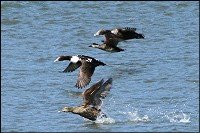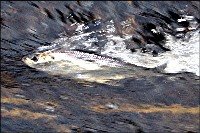Yesterday, while out walking along a narrow strip of meadow beside the river, we saw a Northern Flicker flying low towards us and we were a bit disappointed that it continued on a distance before landing, too far from us to take a picture of it. Having forgotten about the Flicker we were delighted upon our return homeward to find it where it had landed, standing beside an ant hill, which is their food of choice. Its distinctive markings told us that it was a female Yellow-shafted Northen Flicker. Its grey crown,
Having forgotten about the Flicker we were delighted upon our return homeward to find it where it had landed, standing beside an ant hill, which is their food of choice. Its distinctive markings told us that it was a female Yellow-shafted Northen Flicker. Its grey crown,  brown face, red nape crescent, black crescent on its breast are all distinctive markings of both the male and female but the male also has a black malar, which this bird was lacking. In the east we have the Yellow-shafted version of the Northern Flicker, while in the west the Red-shafted version dwells. Where does the naming of yellow-shafted come from? The origin of this distinctive naming was immediately understood as this flicker took off in flight!
brown face, red nape crescent, black crescent on its breast are all distinctive markings of both the male and female but the male also has a black malar, which this bird was lacking. In the east we have the Yellow-shafted version of the Northern Flicker, while in the west the Red-shafted version dwells. Where does the naming of yellow-shafted come from? The origin of this distinctive naming was immediately understood as this flicker took off in flight!

















15 comments:
When I lived in Alberta, which has both the red- and yellow-shafted, I occasionally saw birds I thought could be the hybrids the field guides mention; there was a lot of color variation in the reds. Wonderful photo you got of the wings at lift-off!
The last photo is amazing!
We have Flickers around here too due to the fact we also have plenty of ants. There are a few ant hills, but lots of ground ants. That shot in flight is wonderful.
Thanks for sharing.
How I envy you getting that close to a Flicker! Wonderful pictures! Cheers, Klaus
deb:
I had read of hybrids this morning also. They sound interesting. I wish I had of had more interest in birding when I lived in Alberta for a couple of years.
kjpweb:
I was very surprised to see it again, as if it had waited for us. I managed to get four good photos before it took off, but it this case, its leaving was the best.
I visited your blog yesterday and am totally in awe of your great photos! Thanks for your visit.
becky and bobbie:
Glad that you both enjoyed.
If I had known that Flickers loved ants, maybe I wouldn't kill so many ants! It's a beautiful bird and you took wonderful photos to show all the markings. Especially that last photo that shows the yellow under the wings! Really terrific post!
mary:
I had never been this close to a Flicker before and thought myself fortunate. Glad that you enjoyed.
Congratulations on having a warbler in your yard!
The Flickers are such colourful birds - it always makes my day when I see one. Your photos are wonderful - very pretty wings in the last one. :)
Great shots what a great looking bird.
Does anyone know if flickers simply eat ants, or do they ever engage in "anting", like Jays and others do?
deb:
Good question for I had never heard of 'anting' before. Doing a quick google search with the words, "flickers and anting" I came up with a few sites stating that they do. Here's the url from Wikipedia on this subject. Anting is mentioned under the sub title, diet.
Thanks for the mention.
Love the flicker..I have learn to use the proper words like "malar". But I can never remember them when I need them.
Last summer I kept hearing a strange "wacka..wacka" call and finally saw a northern flicker to go with the call.
Great photos and info..note to self.."malar".."malar"..."malar" GG
Ann..I can't comment on your Flowers blog..but you have helped me to identify a couple of plants here..Thank you!!!!!!!!!!!!!!
You change your header photo so often, I can barely keep up! Love the geese....before they disappear!
Thanks for the link to the Wiki site about Flickers and anting. Another interesting thing I heard while living in up the foothills was that early-arriving hummingbirds (we had mainly the Rufous) will drink sap from sapsucker holes if flowers are scarce.
Post a Comment